A celebrity wedding... on the run
the historic marriage of a Polish princess and an exiled royal
Over the years the media has bombarded us with gossip, news and photos of celebrity weddings. Do you remember watching the televised wedding of Diana and Charles in 1981? Were you able to ignore last month’s Venetian event? The 50th article for “The Painted Palazzo”, (read others in the Archives) is the intriguing story of a royal wedding that took place 306 years ago.
The marriage between a teenage Polish princess and the 30 year old heir to the English throne in exile was the most talked about celebrity wedding of the 18th century. It was secretly organized and carried out to link the two Catholic dynasties of Europe and give an heir to the exiled Stuart family.
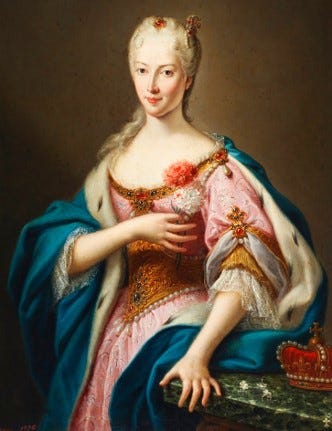
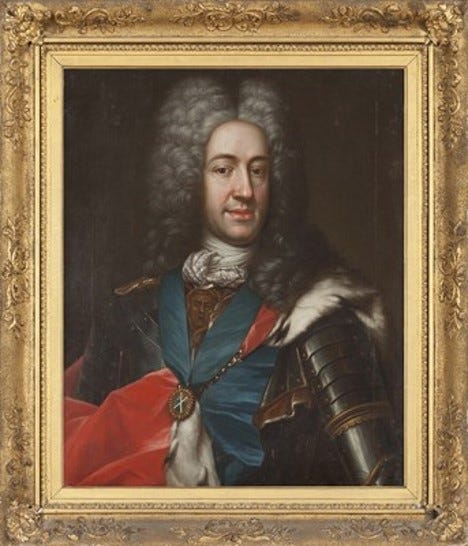
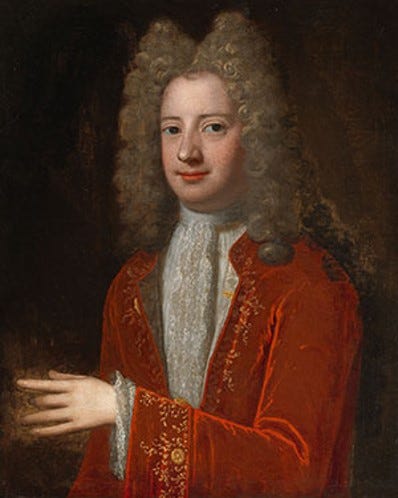
Maria Clementina Sobieska James Edward Stuart Charles Wogan
The “wedding planner” for this secret marriage was an Irish officer loyal to the Jacobean cause, Charles Wogan, who was sent as emissary to the Polish court to search for a suitable bride for the exiled Stuart prince, also known as the “Old Pretender.”
In the autumn of 1718, Maria Clementina Sobieska, the young princess selected by Wogan, left Poland accompanied by her mother Princess Hedwig Elisabeth and travelled to Innsbruck where the Hanoverian ruler had them imprisoned to prevent them from going any further. They passed part of the winter at the palace of Baron von Greiffen, now Palais Trapp, located at 38 Maria Theresien Strasse in the center of the city. The palace, where later 13 year old Mozart gave his first piano concerts, stands out even today for its elegant internal garden and carriage entrance topped with a noble coat of arms
.
imprisoned by Gen. Heister in Innsbruck
Charles Wogan, responsible for the flight of Maria Clementina to a promised new life in Italy, had also reached Innsbruck and was lodged on the other side of the Inn River. Wogan’s task, to secretly whisk the princess to Rome, began with the organization of food and wine for the journey including cooking chickens for the trip. Evidently he was not much of a cook, because this food caused terrible stomach aches to members of the group during their adventurous escape.
For the journey, Wogan rented a large carriage with special springs, double reins and ropes which had to be pulled by six horses. The group was made up of a reckless coachman, three trusty Irish officers- Arthur Dillon, Major Richard Gaydon and the handsome Captain Luke O’Toole who, along with Wogan, provided protection.
Even before the secret departure from Innsbruck a few problems occurred. The maid Jenny, who was to remain behind in Innsbruck to impersonate the princess, caused last minute panic for refusing to wear a modest dress and flat shoes. Her pride was "bought" with the promise of a gift of dresses. In the confusion of the secret departure, a large case containing Sobieski family jewels and other gifts offered by the Stuart family for the promised marriage were left behind. The courageous Captain O'Toole turned back to recuperate the case and jewels and the expedition was able to depart. The escapees, equipped with fake passports in the name of “Count de Cernes”, pretended to be a Flemish family traveling to the sanctuary of Loreto to fulfill a vow.
Today it takes about four hours to make the 400 km. journey from Innsbruck over the Alpine passes to Bologna, but for the small group travelling incognito it was a frightening five day marathon!


the route passed by several fortified castles
The group included Captain Misset and his wife, Lady Misset who was 5 months pregnant and Michele Vezzosi, a trusted Italian valet. Wogan and the other officers spoke various languages and were able to entertain the curious young princess with stories of their adventures, answering her questions about manners and customs of England and teaching her a few phrases in English.
During the five days of arduous travel, the convoy passed by the castles of Trento, Bressanone and Rovereto always fearful of being recognized and captured. They suffered from lack of food, the cold and from the difficulty of finding a regular change of horses. April was coming to an end, but in the mountain passes they were surprised by snowstorms and rain and the roads had dangerous cliffs and precipices. At a certain point the carriage axle broke and had to be repaired, leaving the small group on foot.
After crossing the border into Italy, they felt safer and eventually arrived in Bologna where they were welcomed by Cardinal Origo, a friend of the Sobieski family. The presence of the bride-to-be in Bologna had to be kept secret until it was possible to celebrate a first proxy marriage. Sources say it was James Murray, a friend of the Stuart cause, who represented the absent James. The rite that united the two Catholic royal houses -Sobieski and Stuart- was celebrated on May 9,1719 and is immortalized by a miniature in volumes commissioned by the Elder Consuls of the city of Bologna.
To confuse the spies of the English crown, James had gone to Spain, departing from the port of Nettuno, south of Rome and when he received the announcement of the proxy wedding in Bologna, he returned and met Clementina in Rome. Later they traveled to Montefiascone where the official ceremony was openly celebrated. The royal couple and a group of gentlemen and ladies of the Jacobean court were guests of the local bishop in the beautiful town of Montefiascone overlooking Lake Bolsena. They all spent a month’s honeymoon taking part in the local life, enjoying the food and wine- for which the town is celebrated- and taking boat rides on Lake Bolsena.
The story of the dramatic flight of the young Polish princess and the subsequent marriage was published in 1722 with the signature of Charles Wogan and the title "Female Fortitude -narrative of the seizure, escape and marriage of the Princess Clementina Sobiesky" . It was a best seller and Wogan’s name became famous in all of Europe. For his commitment and courage he was appointed "Senator" of Rome by Clementina’s godfather, Pope Clement XVI (along with the other Irish officers who took part) and ended his career as governor of "La Mancha" in Spain.
After Story and art objects
The royal couple had two sons, Charles Edward/Bonnie Prince Charlie, and Henry Benedict, who became a Cardinal and whose travels in central Italy during the years 1764-1776 are described in official diaries scrupulously kept by his secretary, Don Giovanni Landò. The 36 volumes of the diaries in Italian are bound in Moroccan leather and preserved in the Manuscripts Room of the British Library in London. They formed the source for my bilingual publication “Travels to Tuscany and Northern Lazio”.
The marriage of the Sobieski-Stuart couple was not a happy one and ended when Clementina escaped again - this time to live in a convent in Rome, now the Conservatory of Santa Cecilia. Here she passed away at the age of only 33. Several tombs and magnificent funerary monuments dedicated to the Stuart-Sobieski family can be admired in St. Peter’s Basilica in Rome.
Over the years Stuart objects and portraits of family members have sold at specialized auctions. Some examples are a beautiful jewel with a double portrait of Maria Clementna and James, in memory of the royal wedding, which was given to a loyal Stuart supporter- Captain Creyke- then sold at auction in 2019 for £7,500.
Magnificent bronze medals by the sculptor Hamerani were used as gifts and propaganda against the Hanovers. A beautiful one represents Clementina’s flight as a young princess, while another, found in the gardens of the bishop's villa (now Villa Balestra) on the Palanzana hill, in Viterbo, is a reminder of Cardinal Henry Stuart's visit to the city and his stay at the Bishop’s villa in 1776.
For political reasons, the two sons of the royal couple were subjects of many official portraits. Henry David made portraits of them between 1729-32 and miniature copies were given to faithful Jacobites. Several noble Italian families who hosted the Stuarts in Italy over the following 90 years - such as the Corsini of Florence (see photo below), and the Agostini Venerosi della Seta of Pisa - received similar gifts. Their descendants still jealously guard these gold tobacco boxes and miniature portraits on ivory and copper.
During a stay in Venice in 1737-38, the young princes sat for Venetian painter Rosalba Carriera and later copies were made by the architect Francesco Guardi.
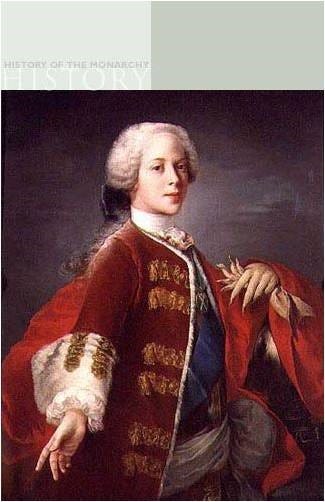
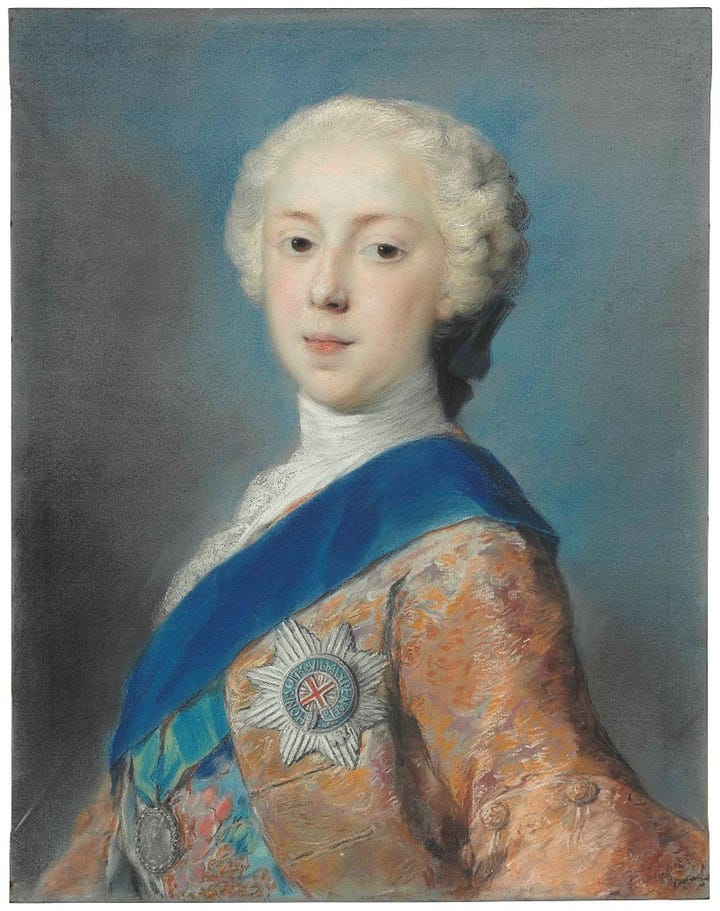
The only portrait of Prince Charles made while he was in Scotland is the one by Allan Ramsay who portrayed the (then handsome) prince in 1745 during the disastrous invasion. A few years ago, the picture was rediscovered by Prof. Bendor Grosvenor. After 250 years it was still hanging in the same place - a corridor on the ground floor- of Gosford House in Scotland!
books and conferences about the royal wedding of 306 years ago
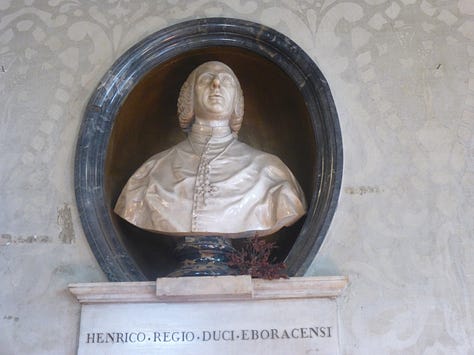

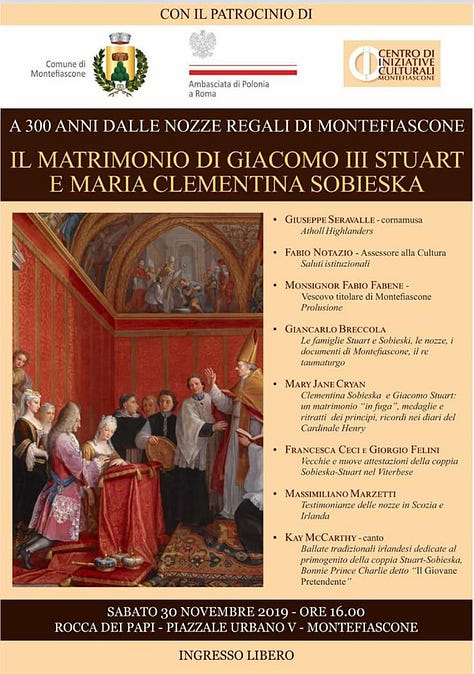
Rudolf von Granichstaedten-Czerva, Alt Innsbrucker Stadhauser und ihre Besitzer, vol. 3, 1965, p1-32 (Thanks to Prof. Lukas Madersbacher of Innsbruck for the information)
Prof. Maurizio Ascari, "Giacomo III Stuart nella Bologna del Settcento: una cronaca illustrata", Il Carrobbio n. XXVIII, 2002, pp 107-30
Francesca Ceci -numerous articles and conferences in Italian available on academia.edu
Mary Jane Cryan, "Travels to Tuscany and Northern Lazio", Etruria Editions/Ghaleb editore, Vetralla, 2004
-Cryan -"Etruria,Travels, History and Itineraries in Central Italy", Etruria Editions/Archeoares, Viterbo, 2010
-Cryan -"Etruria - Storie e Segreti", Etruria Editions/Archeoares, Viterbo, second edition, 2019
Margaret Stenhouse, "The Flight of the last Stuart King", Austin Macauley, London, 2019- historical fiction about the later life of Cardinal Henry Stuart





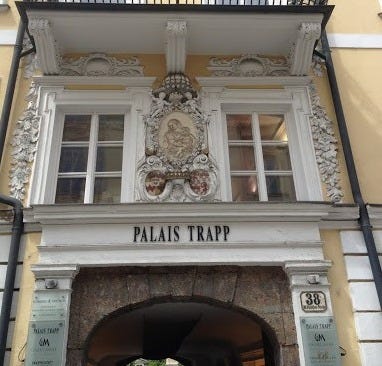
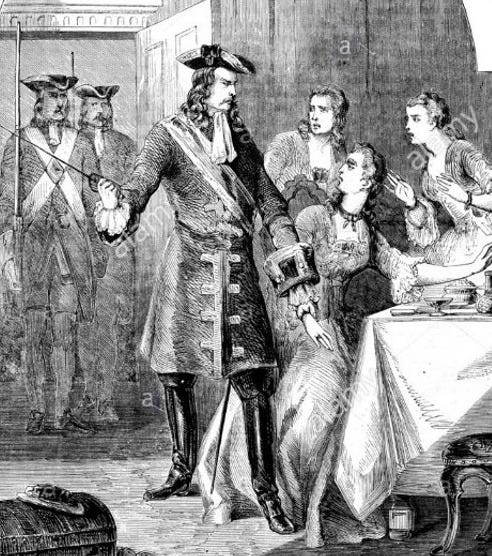
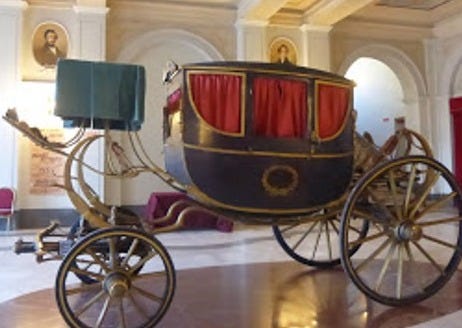
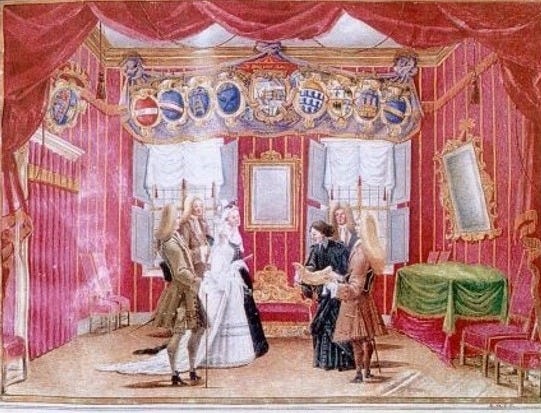
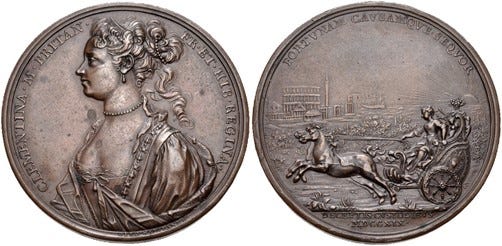
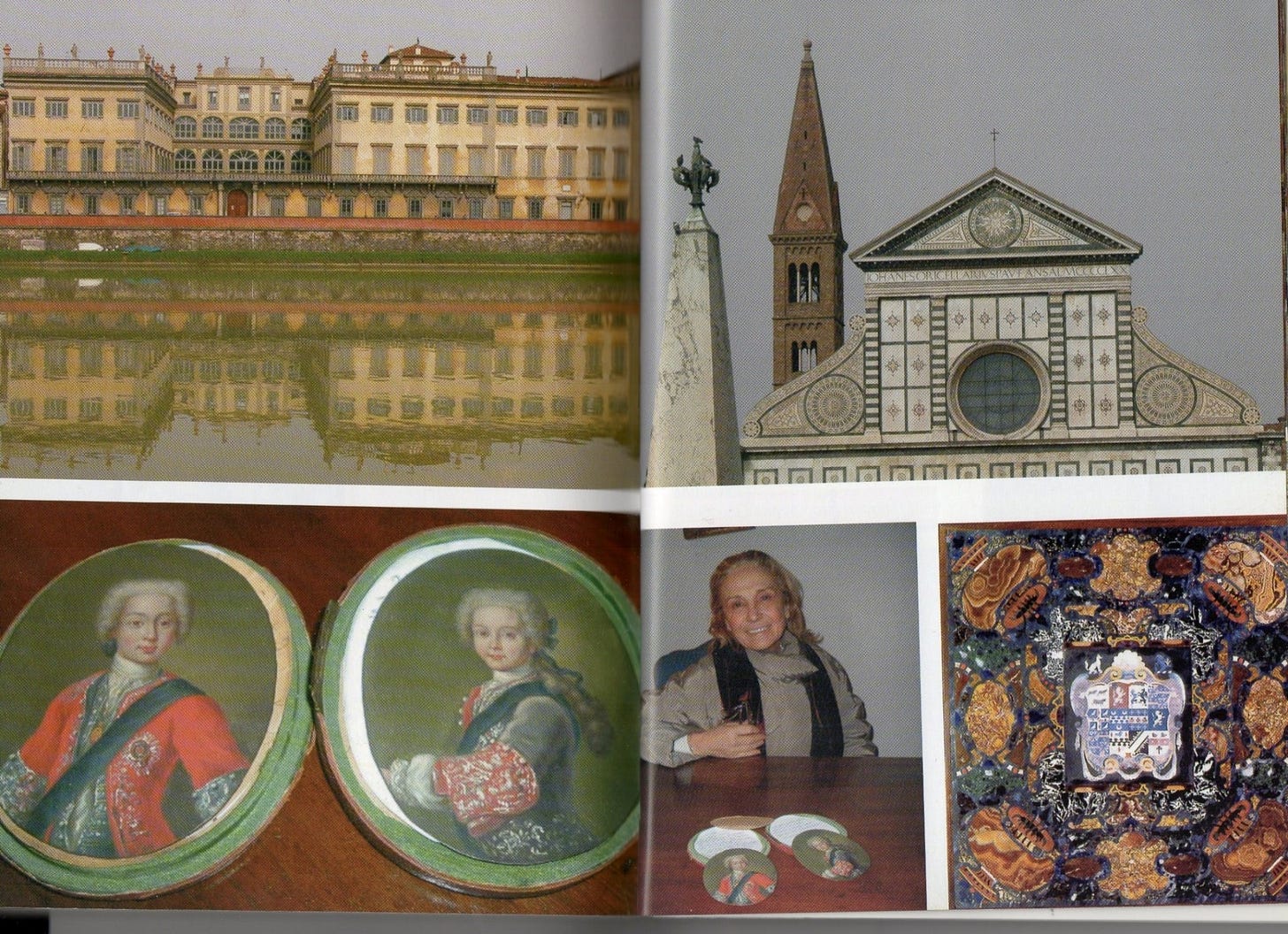
Very interesting. I wonder if Cardinal Origo was an ancestor of Iris Origo's husband.
Fascinating!